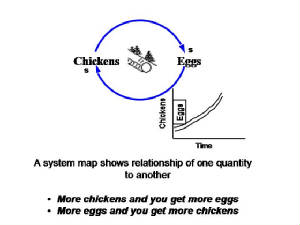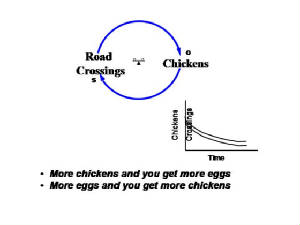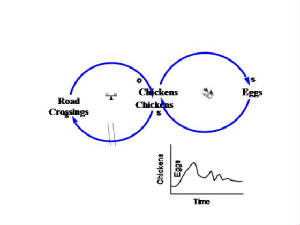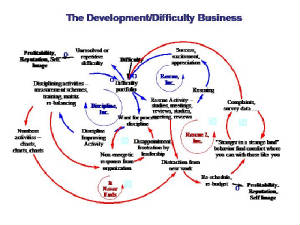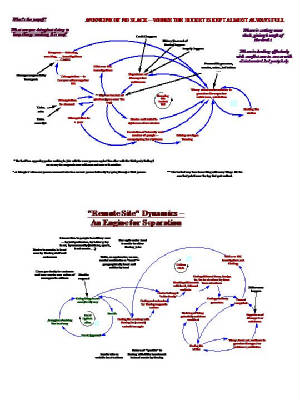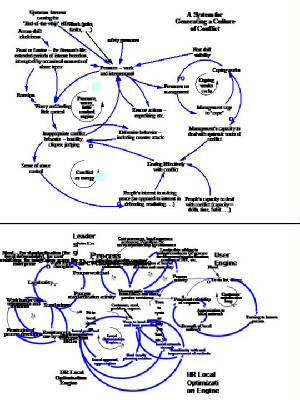System Dynamics Notation and Practices
.
What's here is an introduction to the notation of system dynamics causal mapping. It uses a simple
system of chickens, eggs and chicken road crossings to illustrate reinforcing loops, balancing
loops, and time delays.
.
An important principle and
practice is to assure that every link in a system dynamics causal mapping represents a causal relationship between variables
(and not merely a correlation). For example, while ice cream sales and murder rate may be correlated, there is no causal
relationship between them (although there is a causal relationship between average temperature and ice cream sales and another
causal relationship between average temperature and murder rate).
|
Chickens and eggs. Systems thinking isn't much interested in the question
of which came first -- the chicken or the egg. That's the province of process thinking. . Rather, systems thinking is interested
in the relationship between chickens and eggs:
- With more chickens you more eggs. (Or, with fewer chickens you get fewer eggs)
- With more eggs your get more chickens. (Or with fewer eggs you get fewer chickens)
Such a loop gets called a reinforcing loop (that's
what the snowball-rolling-downhill icon denotes). And the letters "s" stand for
"same" -- that is, more and your get more or fewer and you get
fewer. |
|
. . . Chickens and Road Crossings. For our simplistic example, assume our
system under examination also involves the chicken crossing the road (perhaps when they run out of food in this side of the
road. In systems notation, that would look like the drawing on the left that you would read as: - With more chickens
you'd get more road crossings (perhaps because food gets in short supply)
- With more road crossings you get
fewer chickens
Such a loop gets called a balancing loop denoted by the little balance icon in thee center. Again the "s"
stands for same (more gets more or fewer gets fewer) and the "o" stands for opposite (more gets fewer or fewer gets
more). |
|
|
A Simple System of Chickens, Eggs, and Road Crossings. By now you can probably read the notation of the system to the left. One
more bit of notations is added -- the double hash marks denoting a time delay. We could continue to add more elements
and dynamics -- sales of Colonel Sandars KFC perhaps, or the price of chicken feed. We'll never capture all of the elements,
dynamics, entanglements, but rather as one listens to the story of an organizational situation, the important elements, dynamics,
and entanglements rather readily come into view -- even seem obvious once they are brought into view.
|
Here are some examples of what organizational system dynamics can look like. They're
intentionally too-small-to-read because the context for each is important and the context and its associated dialog and insight are
central to the process of: . bringing into view the essential dynamics of the system under consideration each person seeing what they are doing/not doing to keep things working the way they are individually and collectively committing to changes that will deliver the desired system behavior.
|



